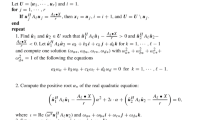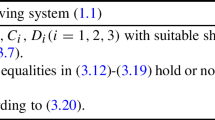Abstract
In this paper, we derive some necessary and sufficient conditions for two, three and four quaternion matrices to be block independent in the least squares inverse, the minimum norm inverse and the {1,3,4}-inverse, respectively. Moreover, it is shown that, quite surprisingly, two, three and four ordered quaternion matrices are block independent in the {1,3,4}-inverse if and only if they are block independent in the Moore–Penrose inverse, which at first glance looks to be a weaker condition than the later.
Similar content being viewed by others
References
Ben-Israel A, Greville TNE (1974) Generalized inverse theory and applications. Wiley, New York
Burns F, Carlson D, Haynsworth E, Markham T (1974) Generalized inverse formulas using the Schur-complement. SIAM J Appl Math 26:254–259
Drazin MP (2016) Left and right generalized inverses. Linear Algebra Appl 510:64–78
Fletcher P, Sangwine SJ (2017) The development of the quaternion wavelet transform. Signal Process 136:2–15
Guo W, Liu Y, Wei M (2004) On the block independence in \(\{1\}\)-inverse of block matrix. Acta Math Sinica Chin Ser 47(6):1205–1212
Hall FJ (1975) Generalized inverse of a bordered matrix of operators. SIAM J Appl Math 29:152–163
Hall FJ (1976) On the independence of blocks of generalized inverses of bordered matrices. Linear Algebra Appl 14:53–61
Hall FJ, Hartwig RE (1976) Further result on generalized inverses of partitioned matrices. SIAM J Appl Math 30:617–624
Hall FJ, Meyer CD Jr (1975) Generalized inverses of the fundamental bordered matrix used in linear estimation. Sankhya Ser A 37:428–438
Hamilton WR (1866) Elements of quaternions. Longmans Green and Co., London
Hung CH, Markham TL (1975) The Moore–Penrose inverse of a partitioned matrix \(M=\left[\begin{array}{ll} A \\&B\\ C \\&D \end{array} \right]\). Linear Algebra Appl 11:73–86
Lee M, Kim D (2017) On the use of the Moore–Penrose generalized inverse in the portfolio optimization problem. Financ Res Lett 22:259–267
Liu Y, Wei M (2007) On the block independence in G-inverse and reflexive inner inverse of a partitioned matrix. Acta Math Sinica Engl Ser 23:723–730
Ma J, Li Y (2017) Gauss–Jordan elimination method for computing all types of generalized inverses related to the \(\{1\}\)-inverse. J Comput Appl Math 321:26–43
Marsaglia G, Styan GPH (1974) Equalities and inequalities for ranks of matrices. Linear Multilinear Algebra 2:269–292
Mehdipour M, Salemi A (2017) On a new generalized inverse of matrices. Linear Multilinear Algebra 1–8. https://doi.org/10.1080/03081087.2017.1336200
Meyer CD (1973) Generalized inverses and ranks of block matrices. SIAM J Appl Math 25:597–602
Pei SC, Ding JJ, Chang JH (2001) Efficient implementation of quaternion Fourier transform, convolution and correlation by 2-D complex FFT. IEEE Trans Signal Process 49:2783–2797
Sangwine SJ (1996) Fourier transforms of colour images using quaternion or hyper-complex number. Electron Lett 32(21):1979–1980
Song C, Sang J, Seung H, Nam HS (2006) Robust control of the missile attitude based on quaternion feedback. Control Eng Pract 14:811–818
Tian Y (2004) Rank equalities for block matrices and their Moore–Penrose inverses. Houst J Math 30(2):483–510
Took CC, Mandic DP (2009) The quaternion LMS algorithm for adaptive filtering of hypercomplex real world processes. IEEE Trans Signal Process 57:1316–1327
Took CC, Mandic DP (2010) Quaternion-valued stochastic gradient-based adaptive IIR filtering. IEEE Trans Signal Process 58(7):3895–3901
Took CC, Mandic DP (2011) Augmented second-order statistics of quaternion random signals. Signal Process 91:214–224
Took CC, Mandic DP, Zhang FZ (2011) On the unitary diagonalization of a special class of quaternion matrices. Appl Math Lett 24:1806–1809
Wang Y (1998) On the block independence in the reflexive inner inverse and M-P inverse of block matrix. SIAM J Matrix Anal Appl 19(2):407–415
Wang Q (2004) A system of matrix equations and a linear matrix equation over arbitrary regular rings. Linear Algebra Appl 384:43–54
Wang Q, Song G, Lin C (2007) Extreme ranks of the solution to a consistent system of linear quaternion matrix equations with an application. Appl Math Comput 189:1517–1532
Wei M, Guo W (2002) On g-inverses of a bordered matrix: revisited. Linear Algebra Appl 347(1–3):189–204
Wie B, Weiss H, Arapostathis A (1989) Quaternion feedback regulator for spacecraft eigenaxis rotations. J Guid 12:375–380
Yan Z (2014) New representations of the Moore–Penrose inverse of \(2\times 2\) block matrices. Linear Algebra Appl 456:3–15
Zeng R, Wu J, Shao Z, Chen Y, Chen B, Senhadji L, Shu H (2016) Color image classification via quaternion principal component analysis network. Neurocomputing 216(5):416–428
Zhang F (1997) Quaternions and matrices of quaternions. Linear Algebra Appl 251:21–57
Zupan E, Saje M, Zupan D (2009) The quaternion-based three-dimensional beam theory. Comput Methods Appl Mech Eng 198:3944–3956
Acknowledgements
This research was supported by the Post-Doctoral Fund of China (2015M571539), the Doctoral Program of Shan Dong Province (BS2013SF011), Scientific Research of Foundation of Shan Dong University (J14LI01) and Scientific Research of Foundation of Weifang (2014GX027).
Author information
Authors and Affiliations
Corresponding author
Rights and permissions
About this article
Cite this article
Song, G., Zhou, Y. Block Independence in Various Generalized Inverses of Partitioned Quaternion Matrices. Iran J Sci Technol Trans Sci 43, 1071–1080 (2019). https://doi.org/10.1007/s40995-018-0534-8
Received:
Accepted:
Published:
Issue Date:
DOI: https://doi.org/10.1007/s40995-018-0534-8




